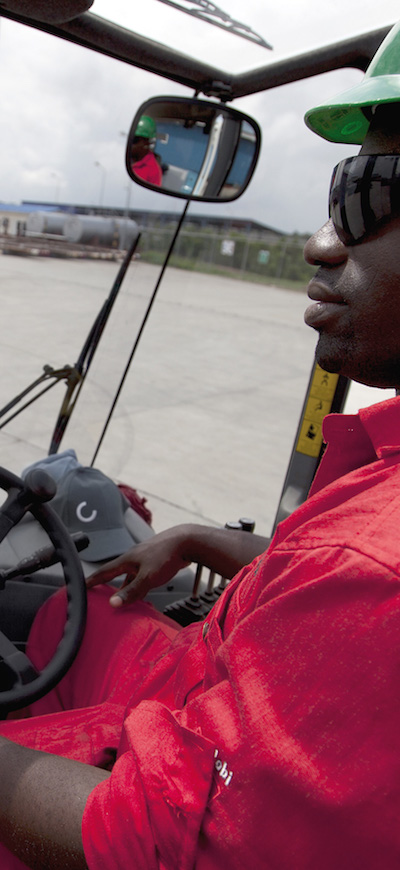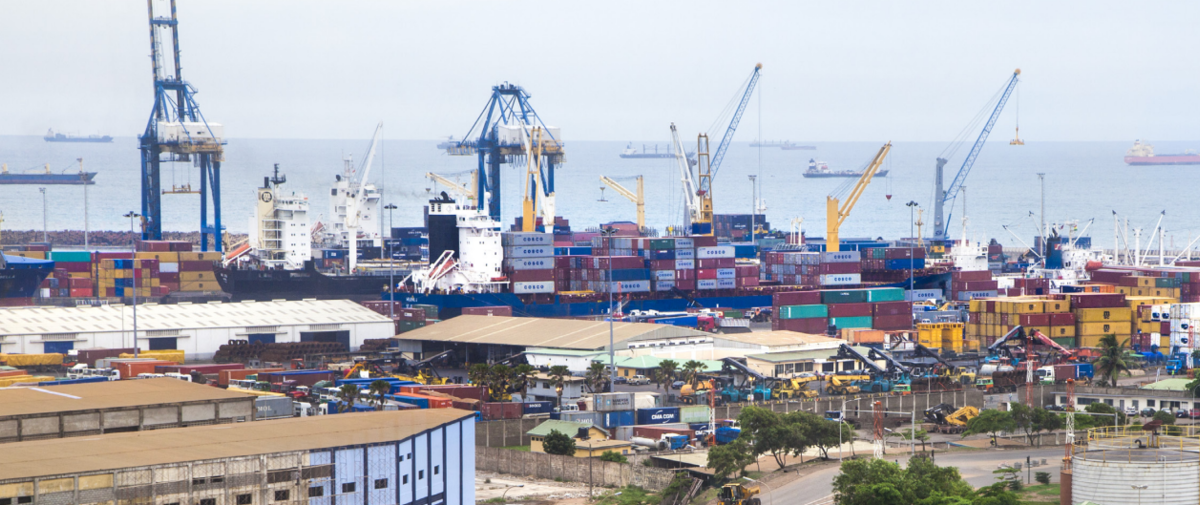Paterson Simons & Co. (Africa) Limited has a well-earned reputation in Ghana as a company that takes good care of its customers.
Paterson Simons & Co. (Africa) Limited has a well-earned reputation in Ghana as a company that takes good care of its customers. Konecranes and Paterson Simons/Pasico make a strong team: Konecranes as manufacturer of lift trucks, and Paterson Simons/ Pasico as distributor of Konecranes lift trucks. The two companies have many values in common and always pay careful attention to customer needs.
Ghana’s economy is booming. Oil was discovered a few years ago, and Ghana looks set to become a key player in the energy industry. Gold has been a staple Ghanaian export for decades. Ghana is also the world’s second-largest producer of cocoa, which along with other agricultural products like rice, nuts, and timber, contributes to a GDP that has almost quadrupled since the turn of the century.
Ghana’s ports are essential for the country’s present and future prosperity, being the hubs of the country’s import and export activities.
Enter Paterson Simons/Pasico
Paterson Simons & Co. (Africa) Ltd., based in the U.K., was founded in 1948. Its subsidiary, Pasico Ghana Ltd., was founded in Ghana, also in 1948. The original business was based on building materials and general trade. As time passed, it added mobile hydraulic equipment to its product range. Paterson Simons/Pasico started to distribute Konecranes lift trucks exclusively in 2002. To date, the company has sold over 200 Konecranes lift trucks across West Africa. Paterson Simons/Pasico is known for selling high-quality equipment and backing it up with friendly, high-quality service.
 Ghana Ports and Harbours Authority (GPHA)
Ghana Ports and Harbours Authority (GPHA)
Ghana Ports and Harbours Authority (GPHA) has the most important role in managing Ghana’s ports, operating across all of Ghana’s major ports along its 539 km of coastline. Richard A. Y. Anamoo, Director General of the GPHA, is justifiably proud of the organization he heads. For over 25 years, Mr. Anamoo has worked in various capacities in GPHA, from Port Civil Engineer to Project Engineer and Chief Engineer. He is now both Director of the Port of Tema and Director General of GPHA, and his long experience means he has a deep understanding of every level of GPHA’s operations.
GPHA wanted to deal with a well-established and reliable company when buying its container handling equipment. Purchasing steadily from Paterson Simons/Pasico since 2002, GPHA has built up a fleet of 20 Konecranes forklifts and 35 Konecranes reach stackers.
From the 10-ton SMV 10-1200 B up to the 32-ton SMV 32-1200 B RoRo, GPHA uses their Konecranes forklifts mainly for general cargo handling. The Konecranes reach stackers are principally used for quayside operations, especially vessel unloading and moving containers ready for devanning.
GPHA mainly has 45-ton models such as the SMV 4535 TB5, but keeps a few 10-ton SMV 108 TB6s on hand for empty containers.
Stephen Owiah, Port Mechanical Engineer at GPHA Tema Port with substantial experience working across Ghana’s major ports, knows these Konecranes lift trucks well. They are operated around the clock, so Mr. Owiah is pleased that visibility from the cab at night is very good. Safety is always a top priority, so he also likes the Konecranes advanced safety features. “Speed limiting due to load on the boom – that is excellent,” he said. Overall, he is very satisfied with the equipment: “It is extra reliable.” He added that the overall design and compact size makes it easy to use, and is particularly impressed with the automatic lubrication on the chassis, which reduces the amount of time needed for maintenance and keeps things working continuously when time schedules are tight.
Port of Tema
About half an hour’s drive east of the Ghanaian capital Accra, you find the industrial town of Tema and the Port of Tema. Originally a fishing village, the port started operations in 1962, and is now the busiest and biggest seaport in the country, handling over 10 million metric tons of cargo every year.
The Port of Tema’s Golden Jubilee Terminal was commissioned in 2007 to reduce congestion at the main terminal when the volume of containerized imports and exports outgrew the original port. It provides modern facilities for the receiving, storage, and forwarding of cargo, working as an off-dock devanning terminal. Golden Jubilee can handle up to 250 containers per day when working at full capacity.
This is an excellent place to observe how a well-run container terminal works. Everything is extremely well-organized, down to the very last detail. The Terminal Operating System knows where every container is at any given moment. Container movement is carefully scheduled so that devanning is efficient: containers stay in the port for the minimum amount of time. Empty containers are stacked in a storage area, ready to be re-filled with exports and taken back to sea.
Evans Mensah, Engineering Superintendent at the Golden Jubilee Terminal, described how GPHA customers really like the service at Golden Jubilee, not only because the terminal is very efficient, but because they know their cargo is safe. “Our security is very good,” said Mr. Mensah.
Port of Takoradi
In order to get a full picture of the GPHA’s operations, we now visit the Port of Takoradi, on Ghana’s west coast. It opened in 1928, and today it is the second-busiest port in Ghana. Recently, it has been expanding its cooperation with developing resource areas, being close to gold, mineral, and oil production. It is also an important center for cocoa export. New facilities for storage and bulk handling should be completed over the next three years to service a growing volume of ship traffic and fast-expanding railway links to nearby mining areas.
Jacob Adorkor, Acting Director of Port, Tema Port, explained how expansion has increased the need for lifting equipment. Part of the GPHA Konecranes truck fleet is used here, and Takoradi port recently ordered four more reach stackers. The volume of materials passing through the port today is over five times greater than what it was barely six years ago.
They were using a crane with a spreader before they bought some reach stackers. Mr. Adorkor said the new equipment has completely changed the way the drivers do their work, making it both faster and much safer. He liked the flexibility and maneuverability of the Konecranes reach stackers in small spaces, and was very impressed with their ability to “reach over a three-high stack of containers and get in behind”.
George Frederick Barnes, the Port Mechanical Engineer, said that Konecranes was chosen through Paterson Simons/Pasico because the trucks fulfilled their technical requirements. Since using them, he has noticed “they are especially stable and reliable in their performance”. The Principal Port Mechanical Engineer, Ben Klu, agreed and added: “The after-sales service is good with Pasico”.
Tullow Oil and Kosmos Energy
Offshore oil has brought exciting new prospects to the Ghanaian economy. In Takoradi, the Tullow Oil storage facility is located next to the local airport. It contains hundreds of drilling pipes of various sizes, ready for transport to the new oil rigs.
Crane rental company Mobicrane has rented out some Konecranes forklifts to Tullow to move the pipes, made of heavy steel in order to withstand the pressure of being kilometers under the sea and under the ground.
The Plant Manager, Major Attike, introduced his drivers, who were full of praise for Konecranes forklifts. They said that the controls are “excellent – intuitive and simple” to use, the truck has “good overall visibility”, and its compact size and small turning circle makes it “easy to maneuver” in the tight spaces of the crowded storage yard.
At another yard, where they handle materials and equipment for energy company Kosmos, the drivers were of a similar opinion. When we asked forklift operator Edmund Odoi Abbey what he liked about the Konecranes forklift, he smiled and said: “Perfect”.
AngloGold Ashanti
AngloGold Ashanti has a number of gold mines in Ghana including the gold mine in Iduapriem, some two hours north of Takoradi, in the western mining area. Before independence, Ghana was called the Gold Coast, and here it’s easy to see why. The mine is very profitable: in the first quarter of 2012, it produced 45,000 ounces of gold. As you would expect, security is tight, and all visitors are checked on their way in and out.
AngloGold Ashanti uses a Konecranes 10-ton SMV 10-1200 B forklift to carry large amounts of supplies. The purchase decision was made after receiving recommendations from other companies operating Konecranes lift trucks, and after seeing a Konecranes forklift in action at a workshop. AngloGold’s forklift is always in demand, so they are considering buying more soon.
Ben Otu-Laryea, the Assistant Workshop Manager, is very pleased with its performance: “We bought it in 2008. We use it a lot and it is still running well,” he said. “It is very easy to maneuver and correct when the load is not straight.”
Ghana’s gleaming future
Ghana is a special place. With its abundant natural resources, friendly and hard-working people, and welcoming climate, Ghana has already achieved much. Its busy, expanding ports are serving a healthy volume of trade, and a growing level of prosperity that is fast bringing the country into the twenty-first century and beyond.
In cooperation with Paterson Simons/Pasico, Konecranes looks forward to participating in Ghana’s continuing success.

 Ghana Ports and Harbours Authority (GPHA)
Ghana Ports and Harbours Authority (GPHA)